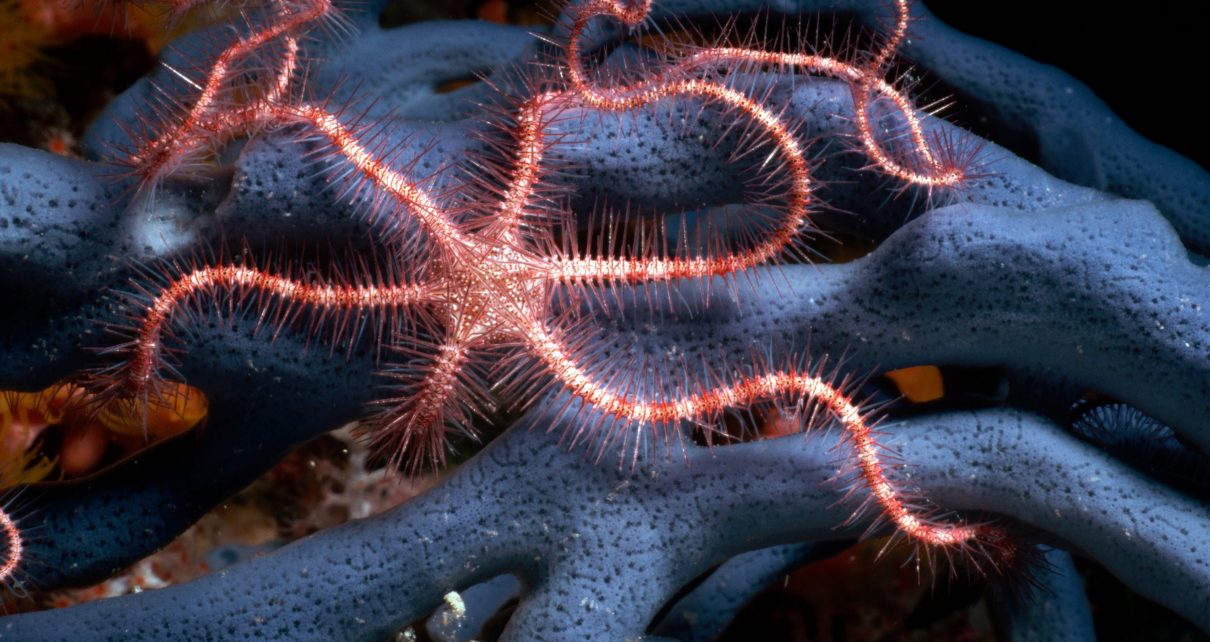The long, squiggly arms of a brittle star—a relative of the sea star with baroque tendencies—have a surprising relationship with the rest of its body.
Its arms function more or less independently, sensing their own environment and making their own decisions about how to react to it. They are only loosely coordinated by a nerve ring in the animal’s core. A single brittle star is almost like five co-joined animals with a mutual interest in where to go, what to eat and making little brittle stars.
And yet now there appears to be something far stranger about the biology of at least one species: the entire body of Ophiocoma wendtii appears capable of forming a blurry but serviceable image, like a squirmy but strangely cute Eye of Sauron.
It gets weirder.
This full-body vision is extinguished at night, when the animal’s sensitivity to light paradoxically increases, and its maroon body turns beige. How and why this animal possesses these strange characteristics were the subjects of a study published in January in Current Biology.
To see, biologists require spatial vision. It isn’t enough to merely detect light; one must form an image. Almost all animals can sense light. Fewer can see.
Traditionally it was pretty apparent who could see and who could not because a creature either had eyes or it didn’t. Recently, however, invertebrate biologists are realizing that eyes may be optional for vision.
In 2018, scientists reported that the spiny sea urchin Diadema africanum is apparently capable of resolving images without eyes—a concept called “extraocular vision.” They did not, however, understand how.
Then a team of European and American scientists led by Lauren Sumner-Rooney at the Oxford University Museum of Natural History began to suspect that, despite a conspicuous lack of eyes, O. wendtii could also see.
They tested this by placing the brittle stars in the center of arenas surrounded by walls with black bars on one side to simulate shelter. More brittle stars ended up at the black bars than would be expected by chance. Dark-adapted beige O.wendtii, however, were not capable of finding these black bars at rates exceeding chance whether they were supplied with fluorescent lights or daylight, seemingly ruling out light intensity or circadian rhythms as an explanation.
This behavioral combination was particularly puzzling because a close relative, O. pumila, has all the same light-detecting equipment, but when placed in the same arenas, these animals end up randomly distributed at any time of day. They are blind.
However, the team knew that the bodies of both brittle stars are studded with light receptors called opsins. O. pumila may not be able to see, but it can sense light; when exposed to light, it hides in sand or crevices right where it is. O.wendtii, on the other hand, skitters to the nearest shelter. The only obvious difference is that O. pumila is not ever red. What difference could being red make to seeing?
In order to be able to form an image, a light receptor needs directionality. If you can’t tell what direction light is coming from, you can’t really infer much about what the world looks like in a particular spot. Consequently, the first requirement for vision after light sensing is some sort of screening mechanism, so that any given receptor knows that the light coming from this particular spot is arriving in this amount.
One method of screening light is (duh) sunscreen. Pigment is natural sunscreen, and O. wendtii is covered in red pigment packets called chromatophores by day. At night, the chromatophores retract. When the scientists scanned both brittle star species and measured the field of view from each animal’s light sensors, they discovered deployed pigment packets narrow the field of vision by physically blocking light. The angular aperture narrows from about 118 degrees to 68 degrees in O. wendtii with chromatophores blazing.
If the light sensors of O. wendtii are directional, that explains how the array widely scattered over their entire body could form an image. Its entire body is indeed an eye. But the image formed might be extremely strange to us. A brittle star is not a ball, like a sea urchin. It is five unruly arms attached to a conciliating core. How does a human even begin to think about what the image formed by such an array might look like?
The scientists attempted to reconstruct an image of a reef inferred by the resolution they measured. In the best-case scenario, a blurry bar of dark gray appears against a lighter gray background. Crude, to be sure, but maybe enough for a motivated brittle star to reach the all-important Minimum Location for Not Getting Eaten.
Since chromatophores block light, that also explains why their general light sensitivity improves at night, which is convenient because vision then may be impossible anyway.
It is intriguing that animals with such a strange system for perceiving their world belong to the major animal group that is the closest kin of vertebrates. Much more distantly related animals—the mighty arthropods (e.g., insects and lobsters) and mollusks (e.g., octopus and squid), most significantly—have eyes. Even some starfish possess proper eyes: compound eyes squeezed into their tube feet, or simple ocelli (the pressure to see well may be stronger for starfish because they are active hunters).
To discover such an alternative vision system in not just one but two such close relatives (sea urchins, like brittle stars, are echinoderms) seems surprising and counterintuitive. On the other hand, that a group of animals with radial symmetry and an apparent nonchalance about getting chopped in two is vertebrates’ closest major relative is also surprising, as has been pointed out many times.
Among vertebrates, many fish, amphibians and reptiles have a third eye, and at least one had a fourth. Flatfish have eyes that migrate around their bodies. Many vertebrates—including mammals—possess light receptors apart from their eyes. If a vertebrate had for some reason adopted radial symmetry, could we have seen equally surprising ways of seeing in our own ranks?




